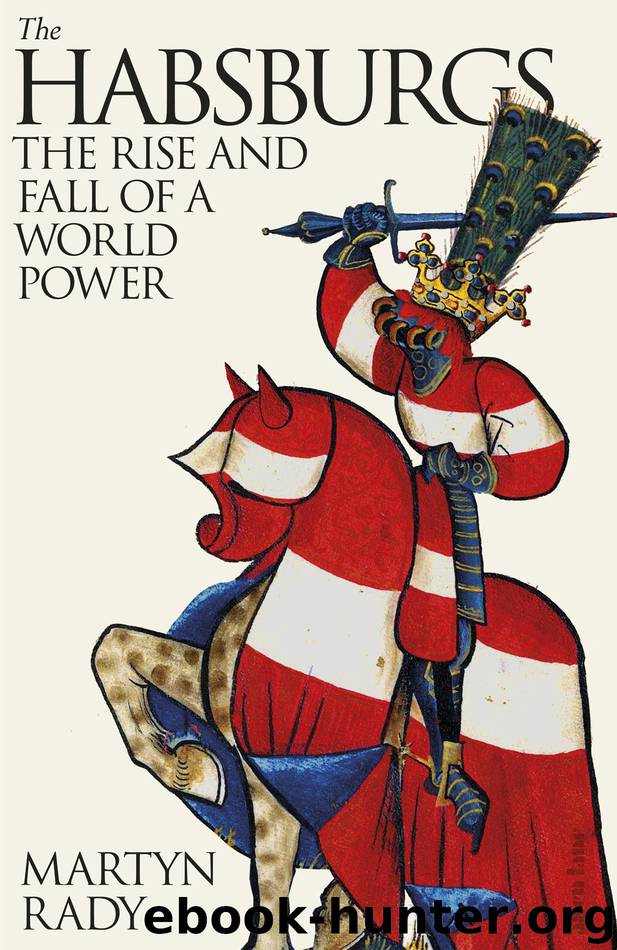The Habsburgs by Martyn Rady

Author:Martyn Rady [Rady, Martyn]
Language: eng
Format: epub
Publisher: Penguin Books Ltd
Published: 2020-03-02T00:00:00+00:00
20
Archduchesses and the Habsburg Low Countries
In the late 1760s Maria Theresa ordered that the Hall of the Giants (Riesensaal) in the Habsburg palace in Innsbruck in the Tyrol be entirely refurbished. She had never liked the gigantic frescoes of Hercules that adorned the walls and gave the hall its name, since ‘there was far too much nakedness here and there.’ Writing in her habitual mixture of French and German, she now instructed that ‘il y aura der Familiensaal anstatt deren risen’—‘there should be a Family Hall in place of the giants.’ The hall was accordingly remodelled, the frescoes concealed with wallpaper, and portraits hung of the empress’s family, but the hall kept its original name.1
The refashioned Hall of the Giants celebrated Maria Theresa’s fecundity. At the far end, she is depicted along with her husband, Emperor Francis Stephen, and her heir Joseph II. But along the walls are vast portraits of all fifteen of her other children, with the dead ones floating together on clouds in the company of a ghostly cherub. Above the portraits of Maria Theresa’s children are twenty of her grandchildren, with spaces reserved for those yet to be born, and several of her more prestigious sons-in-law. Whereas most family galleries were made up of portraits of ancestors, the Hall of the Giants looks to the future—to a dynasty that had survived extinction and was now replenished through the tireless childbearing of the queen-empress.
Of Maria Theresa’s sixteen children, eleven were female, of whom three died young. The eight surviving women are presented in the Hall of the Giants as beautiful and wealthy, attired in the costliest damask. Several are depicted with puppies at their feet as symbols of fidelity. Even though no longer on the marriage market, they are shown as suitable spouses who add lustre to their husbands’ reputations and whose own children will in time make good wives and husbands. By contrast, the males of the family assume martial poses, sometimes with battle scenes in the background.
The main function of Habsburg women was to provide male heirs. It helped if the woman was beautiful, for that made the task of the husband less onerous, especially since it was believed that the womb needed frequent lubrication to prevent it from shrivelling. Charles VI recorded in his diary his relief on finding that his bride, Elizabeth Christine (Lily White), matched expectations—‘queen came … queen nice, beautiful, good.’ Queens too were expected to show modesty and piety by taking part in pilgrimages and religious processions, bathing the (fortunately prewashed) feet of the poor, and upon widowhood retreating into seclusion in the proximity of a convent. Failure to produce the requisite son was often attributed to a spiritual failing, and so fecundity and religiosity were linked.2
The education of Habsburg women matched the expectations put upon them. Languages came first, since they were most likely to contract a foreign marriage. So, besides Latin, they learned Italian, French, and Spanish. Although some German was taught, Habsburg women generally spoke like their aristocratic companions in German dialect, ‘as commonly as their scullion maids.
Download
This site does not store any files on its server. We only index and link to content provided by other sites. Please contact the content providers to delete copyright contents if any and email us, we'll remove relevant links or contents immediately.
| France | Germany |
| Great Britain | Greece |
| Italy | Rome |
| Russia | Spain & Portugal |
Fanny Burney by Claire Harman(25783)
Empire of the Sikhs by Patwant Singh(22170)
Out of India by Michael Foss(16311)
Leonardo da Vinci by Walter Isaacson(11901)
Small Great Things by Jodi Picoult(6092)
The Six Wives Of Henry VIII (WOMEN IN HISTORY) by Fraser Antonia(4788)
The Wind in My Hair by Masih Alinejad(4424)
The Lonely City by Olivia Laing(4118)
The Crown by Robert Lacey(4104)
A Higher Loyalty: Truth, Lies, and Leadership by James Comey(4031)
The Iron Duke by The Iron Duke(3639)
Millionaire: The Philanderer, Gambler, and Duelist Who Invented Modern Finance by Janet Gleeson(3568)
Sticky Fingers by Joe Hagan(3453)
Alive: The Story of the Andes Survivors by Piers Paul Read(3309)
Papillon (English) by Henri Charrière(3269)
Joan of Arc by Mary Gordon(3256)
Stalin by Stephen Kotkin(3084)
Aleister Crowley: The Biography by Tobias Churton(3019)
Ants Among Elephants by Sujatha Gidla(2923)
